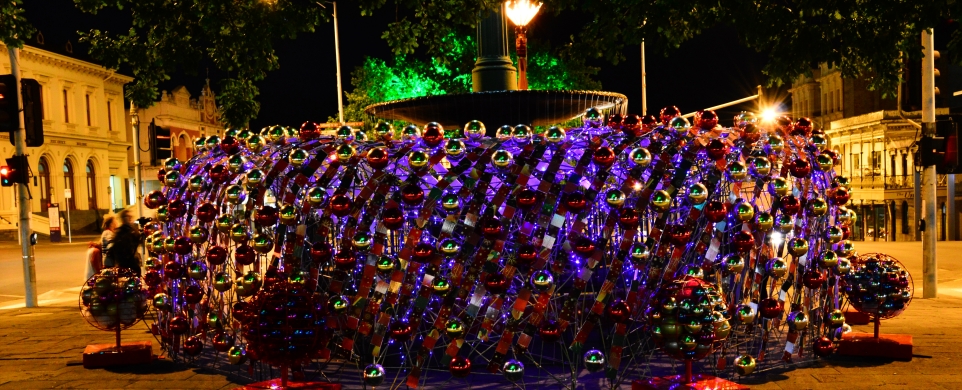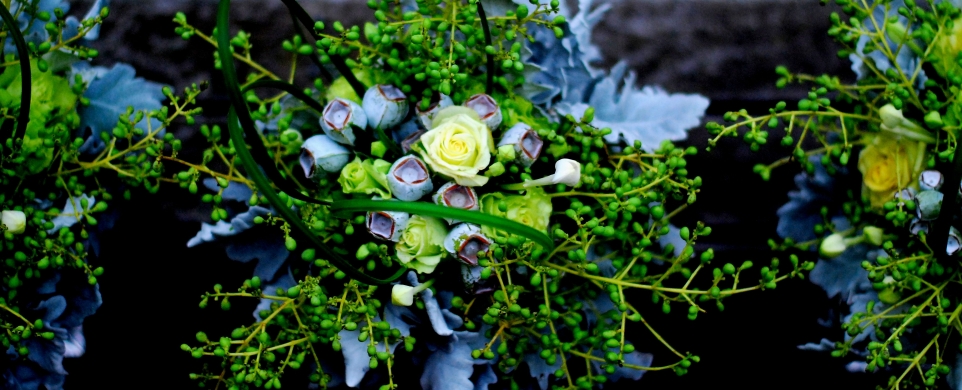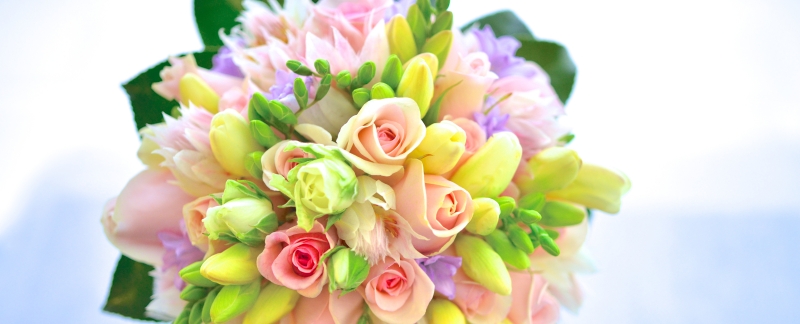Sunday 24 December 2017
Tuesday 19 December 2017
Events Calendar
By shososhimbo
20:58
December 2017: Shoso’s Ikebana display at Lesley Kehoe Galleries. http://www.kehoe.com.au
26 December 2017 to 3 January 2018: Shoso’s Ikebana display at Koko, Crown Melbourne.
14 February 2018: A new term of Japanese Aesthetics at RMIT starts. http://bit.ly/1IFmuyl
4 March 2018: Ikebana Workshop at Kazari. http://www.kazari.com.au/
17 March to 2 April 2018: Lorne Sculpture Biennale. Shoso was selected for the biennale.http://www.lornesculpture.com/index.php
At their conference Shoso will talk about "Environmental Art as Public Art: Beyond an Instrumentalist Perspective" http://www.lornesculpture.com/speakers.php
30 March 2018: Shoso will conduct an Ikebana demo as a featured presenter at the Asian Conference on Arts and Humanities 2018, The International Academic Forum, Kobe, Japan. https://iafor.org
May 2018: The International Floral Art 2018/2019 will be published from Stiching Kunstboek. Shoso’s work will be included. http://www.stichtingkunstboek.com/en/book/detail/5043/international-floral-art-20162017
21 September to 6 November 2018: Biennale of Australian Art. Shoso was selected for the biennale. http://www.boaa.net.au
http://www.shoso.com.au
https://www.facebook.com/ikebanaaustralia
Friday 8 December 2017
Ikebana Today 65
The New Ikebana Movement in 1930’s changed ikebana significantly. Ikebana came to be influenced by the Western Modernism Art Movement. How can we see ikebana today in the context of the international contemporary art? There are many topics to be considered.
1 What was the nature of Modernism Art Movement? When it came to Japan, why was the idea of Ikebana as spiritual training rejected?
2 How did the Modernism Movement change Ikebana?
3 The focus of contemporary art has moved from Modernism to Post Modernism. Should Ikebana keep focusing on the ideas of Modernism? Shouldn’t it shift its focus to Post Modernism?
4 Can Ikebana be a part of the Post Modernism art movement? Can we create contemporary art with ikebana?
5 Do we need to re-evaluate the traditional aspects of ikebana that were rejected by the New Ikebana Movement? How do ikebana practitioners with non-Japanese cultural backgrounds see the traditional aspects?
My recent sculptural work, Whale’s Stomach was an attempt to answer question 4. It won the Arnold Bloch Leibler Prize 2017 at 17th Annual Yarra Valley Arts / Yering Station Sculpture Exhibition. It was a mixture of ikebana elements and non-ikebana elements. I was particularly conscious of the process of creation. Ikebana has taught me that there is a moment when a flower arrangement becomes a work of art. When I reach that point, my work starts to tell its own story.
In making this work, I first made an object with various plastic bags. But the colours of the bags were so diverse that I had to cover the whole object with some large blue plastic wrapping sheets I found on a building site. The colour of the blue is so symbolic and effective. Only when you look closely do you notice the many plastic bags inside.
The next step was to wrap the structure with chicken wire. But I was still not happy. When I took the surface of the chicken wire and created the wrinkles, I realised I'd reached the point where my work started to tell a story. I spent about 3 hours just before installation to create organic patterns on the surface.
I’ll mention this work again sometime in a different context. In particular, this is a good example of the difference between ikebana and contemporary sculpture.
http://www.shoso.com.au
https://www.facebook.com/ikebanaaustralia
Monday 4 December 2017
Thursday 23 November 2017
Sunday 12 November 2017
RMIT Short Courses: From Ikebana to Contemporary Art
By shososhimbo
15:19
In week 1 & 2 our students learn how to make a basic style Ikebana and its 7 design principles. In week 3 they produce a geometrical drawing using at least one of the principles. The students are encouraged to create several design and art projects applying Japanese aesthetics in the course.
14 February 2018: A new term of Japanese Aesthetics starts at RMIT. http://bit.ly/1IFmuyl
http://www.shoso.com.au
https://www.facebook.com/ikebanaaustralia
14 February 2018: A new term of Japanese Aesthetics starts at RMIT. http://bit.ly/1IFmuyl
https://www.facebook.com/ikebanaaustralia
Monday 6 November 2017
Daily Meditation: Events Calendar
22 October until 5 December 2017: Yering Station Sculpture Exhibition 2017. Shoso Shimbo won the Arnold Bloch Leibler Prize 2017 - $5,000. Visit beautiful Yering Station to see Shoso's work, Whale's Stomach as well as wonderful sculptures by Australia's top contemporary artists.
http://www.shoso.com.au/2017/10/contemporary-sculpture-award-for-shoso.html
25 November 2017: Ikebana Workshop at Made in Japan, South Melbourne. Only 2 tickets available. https://www.facebook.com/MadeInJapanAustralia/
26 November 2017: Salvos community fundraising through Ikebana at Kazari, 450 Malvern Rd, Prahran. http://www.kazari.com.au/
14 February 2018: A new term of Japanese Aesthetics starts at RMIT. http://bit.ly/1IFmuyl
17 March to 2 April 2018: Lorne Sculpture Biennale. Shoso was selected for the biennale.
http://www.lornesculpture.com/index.php
30 March 2018: Shoso will conduct an Ikebana demo as a featured presenter at the Asian Conference on Arts and Humanities 2018, The International Academic Forum, Kobe, Japan. https://iafor.org
21 September to 6 November 2018: Biennale of Australian Art. Shoso was selected for the biennale.
http://www.boaa.net.au
http://www.shoso.com.au
https://www.facebook.com/ikebanaaustralia
Saturday 4 November 2017
Ikebana Today 64
Mirei Shigemori’s view on art had a significant influence on Ikebana. It was around the 1930’s that Shigemori advocated a new Ikebana movement with Sofu Teshigahara, the founder of Sogetsu school and Houn Ohara, the headmaster of Ohara school. Shigemori stated that Ikebana is art. What he meant by art is the Modernism movement of the late 19th century to the early 20th century. Some of the artists Shigemori admired include Jean-François Millet and Wassily Kandinsky.
It is necessary to clarify the characteristics of Modernism, and to look into how they influenced Ikebana. Among the three largest Ikebana schools, both Sogetsu and Ohara were influenced by the new Ikebana movement and gained great popularity after the war, becoming the major forces in the largest Ikebana boom in Japanese history. They moved away from many aspects of traditional Ikebana, including the notion of Ikebana as a spiritual training and the traditional attitude of respecting flowers as spiritual entities.
What I am talking about here is probably the most important cultural transformation in the history of Ikebana. Nevertheless, very few people have ever discussed this issue in public, probably because this is a rather inconvenient and concerning topic for some people. It is a good time, however, to reevaluate the new Ikebana movement and reconsider the role of Ikebana in contemporary society. Facing such a huge topic, it might be better to start with a list of questions in the next issue.
This image is a detail of my wedding installation at the Mural hall, Myer in Melbourne. With help from my fantastic team, I transformed the hall into a dream world using about 2000 roses. As I do both installations and wedding bouquets, I am often requested to do this kind of challenging project.
I conducted a Ikebana workshop at Kazari in October as part of Salvo Community Fundraising Events and the next one will be at Made in Japan in South Melbourne on the 25th of November. If your organisation is interested in hosting our workshops, please contact us.
Also please visit Yering Station in Yarra Valley by 5 December to see my award wining work as part of their annual sculpture exhibition.
http://www.shoso.com.au
https://www.facebook.com/ikebanaaustralia
Sunday 22 October 2017
Contemporary Sculpture Award for Shoso
Shoso Shimbo won the Arnold Bloch Leibler Prize 2017 - $5,000 at 17th Annual Yarra Valley Arts / Yering Station Sculpture Exhibition & Awards.
Visit beautiful Yering Station by 5 December 2017 to see Shoso's work, Whale's Stomach as well as wonderful sculptures by Australia's top contemporary artists. Don't forget to vote for your favourite sculpture - RACV People's Choice Award.
Shoso's Statement:
In 2017 a dying whale was found in Norway with over 30 plastic bags in its stomach. The interior of this sculpture is created from plastic waste that is often found in oceans. This work serves as a reminder of how damaging human impact on the environment can be.
References
http://www.huffingtonpost.com.au/2017/02/04/beached-whale-found-with-30-plastic-bags-crammed-in-its-belly_a_21707242/
http://www.smh.com.au/video/video-news/video-world-news/thirty-plastic-bags-found-in-whales-stomach-20170204-4q6hp.html
http://www.shoso.com.au
https://www.facebook.com/ikebanaaustralia
Visit beautiful Yering Station by 5 December 2017 to see Shoso's work, Whale's Stomach as well as wonderful sculptures by Australia's top contemporary artists. Don't forget to vote for your favourite sculpture - RACV People's Choice Award.
Shoso's Statement:
In 2017 a dying whale was found in Norway with over 30 plastic bags in its stomach. The interior of this sculpture is created from plastic waste that is often found in oceans. This work serves as a reminder of how damaging human impact on the environment can be.
References
http://www.huffingtonpost.com.au/2017/02/04/beached-whale-found-with-30-plastic-bags-crammed-in-its-belly_a_21707242/
http://www.smh.com.au/video/video-news/video-world-news/thirty-plastic-bags-found-in-whales-stomach-20170204-4q6hp.html
http://www.shoso.com.au
https://www.facebook.com/ikebanaaustralia
Tuesday 17 October 2017
Daily Meditation: Events Calendar
22 October until 5 December 2017: Yering Station Sculpture Exhibition 2017. Shoso’s work was selected for the show. www.yering.com
25 October 2017: A new term of Japanese Aesthetics starts at RMIT. http://bit.ly/1IFmuyl
29 October 2017: Salvos community fundraising through Ikebana at Kazari, 450 Malvern Rd, Prahran. http://www.kazari.com.au/
25 November 2017: Ikebana Workshop at Made in Japan, South Melbourne. https://mij.com.au/
17 March to 2 April 2018: Lorne Sculpture Biennale. Shoso was selected for the biennale.
http://www.lornesculpture.com/index.php
30 March 2018: Shoso will conduct an Ikebana demo as a featured presenter at the Asian Conference on Arts and Humanities 2018, The International Academic Forum, Kobe, Japan. https://iafor.org
21 September to 6 November 2018: Biennale of Australian Art. Shoso was selected for the biennale.
http://www.boaa.net.au
http://www.shoso.com.au
https://www.facebook.com/ikebanaaustralia
Friday 13 October 2017
Wednesday 4 October 2017
Ikebana Today 63
Mirei Shigemori’s assertion that flowers are nothing more than materials for self expression influenced such major Ikebana schools as Sogetsu and Ohara that gained great popularity after the war. To recognise how innovative this statement was, as well as how radically it was different to how flowers were seen before, we need to look into the origin of Ikebana.
Yutaka Tuchihashi (1990) states that Ikebana developed from the ancient custom of Hanami (flower viewing) by way of establishment of the Rikka style Ikebana. The aim of Hanami seems to be gaining vital force by viewing flowers, in particular Spring blossoms.
In Japanese the word, hana (flower) also means with a different intonation nose, which is the contact point to the outside. Flower can be taken to mean, therefore, the contact point of this world to the outside, the sacred world.
In the ancient Japan, people also took a branch of blossom from the fields and put it in the rice paddocks. They intended to transplant the nature’s life force, that sacred energy, to the paddock wishing for abundant crops. Their attitudes to flower suggest fetishism and manaism.
We can assume that flower was regarded as something full of life force. Its energy was also seen as something mysterious, sacred and contagious. Importantly it also revitalised our souls. Such was the notion of flowers underlying in the development of Ikebana.
Therefore, Shigemori’s teachings denied not just Ikebana as a spiritual training but also Japanese traditional attitudes to flower. We need to further reconsider his attitude, which was influenced by the Western Modernism, from a historical point of view. Do we still need to follow his teachings in the era of Post Modernism?
The image is one of a small works I made for the exhibition of Tomokazu Matsuyama at Lesley Kehoe Galleries, 101 Collins St, Melbourne. I used subdued colours to work with colourful works by Mr Matsuyama.
October is a busy month for me. On 7th and 8th we will hold Wa: Ikebana exhibition at the Abbotsford convent. This is the third annual exhibition by Ikenobo, Ichiyo and my students of Sogetsu school.
From 22nd, my sculptural work will be exhibited at Yering Station Sculpture Exhibition. I’m pleased that my environmental sculpture was selected for this show. Both sites are great to visit.
From 25th, my course, Japanese Aesthetics: From Ikebana to contemporary art will start at the RMIT Short Courses.
http://www.shoso.com.au
https://www.facebook.com/ikebanaaustralia
Tuesday 26 September 2017
Daily Meditation: At University of Melbourne
Ikebana for the Japanese Australian Poetry Festival, University of Melbourne.
http://www.shoso.com.au
https://www.facebook.com/ikebanaaustralia
Daily Meditation: At Hanabishi, Melbourne
We are looking for a few more assistants for a wedding flower project. http://www.shoso.com.au/p/newsletter.html
http://www.shoso.com.au
https://www.facebook.com/ikebanaaustralia
Wednesday 20 September 2017
Sunday 17 September 2017
A Special Bouquet for a Special Family
By shososhimbo
21:22
I made this special bouquet for a special family using a lot of materials from my own garden.
http://www.shoso.com.au
https://www.facebook.com/ikebanaaustralia
Monday 4 September 2017
Ikebana Today 62
I have been talking about Ikebana as spiritual training. However, a very influential Ikebana researcher, Mirei Shigemori stated that Ikebana has nothing to do with either religion or moral teaching and denied Ikebana as a spiritual training. Instead, in 1930, he declared that Ikebana is nothing but art. Shigemori’s declaration has changed the teaching of Ikebana significantly in many schools, in particular, Sogetsu, Ohara and other schools that gained great popularity after the war.
Shigemori encouraged Ikebana artists to use, cut and bend plant materials as they wish, and denied the notions of respecting their natural way of being or having sympathetic attitudes to them. In other words, he regarded the plant materials as mere materials for self expression. Natural materials are just objects to use. This view is noteworthy, because it is so opposed to the Japanese traditional view of nature.
Actually Ikebana has many spiritual aspects to investigate, styles, views of the universe, views of natural materials, and the philosophy of learning called Shugyo. Dr Osamu Inoue discussed many of those aspects in his remarkable book, The Thoughts of Ikebana (2016). However, he did not mention much about Japanese perception of natural materials. He did mention that Yorishiro, a sacred object in Shinto belief, often made of natural materials, might be an origin of Ikebana. Nevertheless, he like many other Ikebana researchers, did not discuss further the connection between Ikebana and Shinto.
Considering that flowers were sacred objects for the Japanese in the Shinto tradition, Shigemori’s attitudes to natural materials, influenced by Western culture, is extremely contradictive.
We also need to assume that there is a huge gap between the traditional Ikebana schools and the new Ikebana schools such as the Sogetsu school. In order to recognise such a difference precisely, we need to reconsider the traditional Japanese view of flower again in the next issues.
The Ikebana work in this photo is a commercial work for a reception. I enjoy experimenting with various designs.
In August, the Ikebana Gallery Awards were announced and the students’ works were viewed by more than 16 thousands people around the world. We are pleased to be able to provide such a rare opportunity to many students for free. On 7 & 8 October, Wa: Ikebana Exhibition will be held at Abbotsford convent. Please don’t miss it.
http://www.shoso.com.au
https://www.facebook.com/ikebanaaustralia
Thursday 31 August 2017
Spring Flowers in Our Garden
By shososhimbo
23:52
Spring: This is certainly the best time for our garden. All of these flowers are great for Ikebana.
http://www.shoso.com.au
https://www.facebook.com/ikebanaaustralia
http://www.shoso.com.au
https://www.facebook.com/ikebanaaustralia
Thursday 17 August 2017
Sunday 6 August 2017
Ikebana Today 61
Is Ikebana spiritual training? In the 16th century, Senno Ikenobo stated that practicing Ikebana might lead you to enlightenment. Many Ikebana practitioners see the truth in his words and Japanese in general seem to regard Ikebana as a kind of spiritual training.
However, it was Mirei Shigemori who declared in 1933 that Ikebana has nothing to do with spiritual training nor any moral teachings. Then, what is Ikebana? Shigemori regarded it as art. His movement is called the Shinko-Ikebana-sengen and it changed Ikebana significantly.
Actually Ikebana was transformed significantly in the Showa period (1926 - 1989). In the 1920s free style Ikebana was seen for the first time. This was a really big change in Ikebana history. Shinko-Ikebana Sengen began in the 1930’s. During the WWⅡ (1939 - 1945), Ikebana had almost disappeared from Japan. After the war, Ikebana suddenly became popular. In the next decades, an Ikebana boom occurred in Japan in which the largest number of people engaged in Ikebana in history.
These changes are all related. The perception of Ikebana as art rather than as spiritual training brought the Ikebana boom in the Showa period. This is most likely due to the influence of Shigemori. I’ll look into more what he was thinking of at that time.
Looking back, I feel that my view on Ikebana was also influenced by Shigemori. If I was convinced that Ikebana was a kind of spiritual training, I would have started it much earlier. I remember talking to one of my old friends about my doubt about Ikebana. Is it really worth doing? Will it take me where I would like to be? Wouldn’t I regret having invested so much time in Ikebana in the future? “As it is the way of flower, it will be good for you” “I suppose” Both of us were not so sure. I could not make my mind for a long time, maybe because of Shigemori.
On 18 August Dr Kobayashi will talk about Ikebana at the University of Melbourne. She is the president of International Society of Ikebana Studies.
I recently started a new project, The Salvos community fundraising through Ikebana workshops. By hosting our workshop, you can earn $200 and donate $50 to a charity. This is ideal for cafes, educational institutions, churches etc. Please check our website.
Please download free Ikebana calendars with this image from my website.
http://www.shoso.com.au
https://www.facebook.com/ikebanaaustralia
Thursday 3 August 2017
Daily Meditation
The Finalists for Ikebana Gallery Award 2017 have been announced. Can you guess which work will be the winner?
https://ikebanaaustralia.blogspot.com.au/2017/08/the-finalists-for-ikebana-gallery-award.html
http://www.shoso.com.au
https://www.facebook.com/ikebanaaustralia














































































